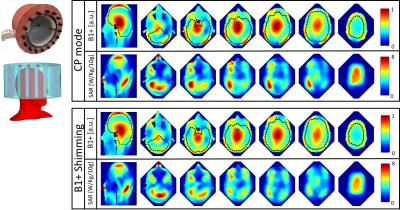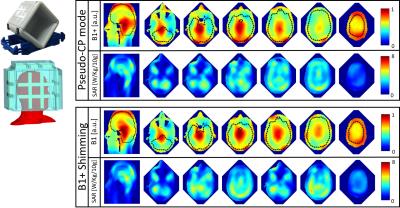4308
64-channel Double-Octagon Tx Head Coil for 7T Imaging1University of Pittsburgh, Pittsburgh, PA, United States, Pittsburgh, PA, United States, 2University of Pittsburgh, PA, United States, 3University of Pittsburgh
Synopsis
This work presents the design of a 64-channel double-rowed head coil (16 octagons with 4 Tx channels on each octagon). The magnetic field ( ) and the specific absorption rate (SAR) generated by the new coil were then compared with the TEM and 16-channel Tic Tac coils using Finite-Difference
Purpose
To develop an RF head coil to address the issues associated with field inhomogeneities, increased SAR and low coverage at 7T.Methods
A 64-channel RF head coil for 7T MRI was designed based on the concept of the 2x2 TTT (cross-pole) head coil(1-3). The new designed Tx array exhibits excitations in 8 different levels in the Z direction of the scanner, potentially improving magnetic field ( ) shimming capability and specific absorption rate (SAR) control. The design was compared to the TEM coil (4 Tx channels, 16 elements) and to the previous version of the TTT head coil (16 channels) by finite-difference time domain (FDTD) simulations, performed using an in-house software. The head model used was Duke, from the virtual family, including the entire head and the shoulders. The FDTD box was constructed using MATLAB (Natick, MA). All simulations considered a scanner with 8kW of RF power capability and each coil was numerically tuned - by adjusting the size of the inner rods inserted in the coaxial elements – until a reflection coefficient lower than -20dB was achieved.
The TEM head coil was evaluated in both circular polarization (CP) mode (quadrature) and RF-shimmed mode, using an optimization (minimization) function implemented in MATLAB. The 16ch TTT head coil was tested in pseudo-CP mode (channels in each level in Z direction have CP phases) and RF-shimmed mode. The new designed 64-channel Tx array was evaluated using two different RF shimming results. The region of interest for all optimizations is the entire head, starting from the cerebellum and excluding the nasal cavities.
Results
The results are shown by the field distribution and SAR maps from each coil. The maps were normalized from 0 to the maximum intensity, while the SAR was normalized to an average fields of 2uT over the region of interest.
Figure 1 shows the results for the TEM coil in the CP mode (Figure 1a) with CV = 27.5% and Max/Min = 23.24. The average SAR is 2.94 W/Kg/10g and the peak SAR is 8.86. The RF-shimmed case was acquired by using the CV as the cost function for the optimization. The results are shown in the Figure 1b, where CV = 23.3%, Max/min = 6.15 and peak/average SAR are 10.53/2.79 W/Kg/10g.
The results from the 16-channel TTT are shown in the Figure 2. For the pseudo-CP mode, CV = 20.1%, Max/min = 4.64 and peak/average SAR is 5.3/1.90 W/Kg/10g. For the RF-shimmed case (CV as the cost function), CV = 17.7%, Max/min = 3.14 and peak/average SAR is 5.82/1.84 W/Kg/10g.
The newly designed 64-channel TTT was tested using two RF-shimming results. The first case results from CV/mean as cost function (Figure 3a). In this configuration, CV = 14.9%, Max/min = 2.45 and peak/average SAR is 1.51/4.97 W/Kg/10g. The second case is resulted from CV/min as cost function, resulting in CV = 16.9, Max/min = 2.91, peak/average SAR = 1.63/5.24 W/Kg/10g.
Discussions and conclusion
The preliminary data shows great potential in the double-octagon 64-ch Tx array for improving magnetic field homogienty and SAR at 7T MRI. The eight excitation levels in Z direction and the eight channels per level significantly increase the degrees of freedom for shimming, and potentially improves the application of pseudo-CP modes and coverage.
The two presented RF shimming cases show considerable improvements in all performance aspects (CV, Max/min, peak and average SAR) when compared to the 16ch TTT and TEM designs. While the first case shows the best performance inside the region of interest, the second case presents a coverage that extends to the neck, which is important for human studies when the position of the patient is not optimal within the coil.
We believe that, with minor variations in the design of the new coil, the CV and coverage will be comparable to a 3T head coil. Moreover, the results shown in this abstract is referred to a 7T scanner with 8kW of power capability, and simulations (not shown here) indicate a considerable improvement (in terms of coverage and signal fidelity) if the RF power is increased to 16kW, with no cost for SAR.
Acknowledgements
This work was supported by NIHReferences
1. Kim J, Krishnamurthy N, Santini T, Zhao Y, Zhao T, Bae KT, Ibrahim TS. Experimental and numerical analysis of B1+ field and SAR with a new transmit array design for 7T breast MRI. Journal of Magnetic Resonance. doi: http://dx.doi.org/10.1016/j.jmr.2016.04.012.
2. Kim J, Krishnamurthy N, Santini T, Zhao Y, Zhao T, Bae KT, Ibrahim TS. Experimental and numerical analysis of B1+ field and SAR with a new transmit array design for 7T breast MRI. J Magn Reson. 2016;269:55-64. Epub 2016/05/31. doi: 10.1016/j.jmr.2016.04.012. PubMed PMID: 27240143.
3. Ibrahim TS, Krishnamurthy N, Santini T, Raval S, Zhao Y, Kim JK, Wood S, Wu X, Yacoub E. 7T RF Coil System with Non-Subject Specific RF Fields & Extended Coverage into the Cerebellum & Temporal Lobe. ISMRM Workshop on Ultra High Field MRI: Technological Advances & Clinical Applications, Heidelberg, Germany. March 2016.


